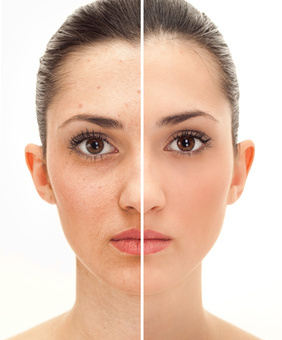
What is Combination Skin?
If you have some areas of your face normal or dry and tight, while other areas are more shiny and oily, you probably have combination skin.
Although this is a very common skin type, it is also one of the most difficult to deal with. You are literally dealing with two different skin types and need to treat them that way. Dry areas tend to be the cheeks. The forehead, nose and chin (T-Zone) will be shiny and may also be prone to pimples and blackheads.
What Causes Combination Skin?
A variety of factors contribute to combination skin—hormones, weather, products, and the over or under activity of your skin’s oil glands. Sometimes it is just genetics. When it comes to combination skin, the causes and combinations are different for everyone.
What Products Work for Combination Skin?
This is where it really gets tricky. It is critical to use products that will work harmoniously to treat and protect both the normal to dry areas and the oilier areas. Otherwise you may make matters worse.
For example, if your oily areas are of concern and you turn to a product that is too harsh you will over stimulate the oil glands causing them to produce even more oils. You will also be drying out the already dry areas even further. On the other hand, if your dry areas are what concern you the most and you turn to a product that is too emollient for the T-Zone, you may cause breakouts and your skin will feel greasy. The dryness may be cause from a lack of moisture (water) in the skin and not a lack of oils at all. There is a difference between dry and dehydrated skin and it is important to know what you are dealing with.
It is always best to seek the advice of an experienced skin care therapist who can analyse your skin and suggest a proper skin care regiment. Sometimes it will take some trial and error to get it just right. It may be necessary to change your skin care routine and products with the changing season as well. Your skin reacts differently to the changing seasons. During the cold, dry winter you may require a different skin care routine than you would use during the hot and humid summer months.
Some product lines offer combination skin care kits as a good starting point. If you are dealing with two very different skin conditions, you may actually need to use different products to treat the different areas of your face. For example, you may need gels, liquids, or oil-absorbing products for your T-zone and creams or lotions or the drier parts of your face. You may also need specific products to spot treat problem areas like break outs or dry patches.
Basics on How to Take Care of Your Combination Skin
Start with a gentle cleanser
Regardless of your skin type or whether or not you wear make up, cleansing is the first step to every skin care regime. Your skin continuously produces sebum (oils) and sweat, it sheds dead skin cells and it is exposed to dust, dirt and pollution on a daily basis. Proper cleansing will remove all of this accumulation and contribute to a healthy, radiant complexion.
Always wash with a gentle, water-soluble cleanser that won’t strip your skin of its essential oils. If you have more oily areas, a gel-based or mild foaming cleanser will work best. If you are experiencing more dryness, a light weight cleansing milk is ideal. Avoid bar soaps or bar cleansers.
Cleansers are not on your skin long enough for active ingredients to actually penetrate so there is no need to spend a lot of extra money on cleansers that market a list of beneficial ingredients.
Use a toner
Using a toner helps ensure that all dirt, oils and left over cleansing residue are completely removed from your face. It is important to find a formula that is especially designed for your skin type. My preferred directions for use are to apply the toner to a cotton pad and wipe the entire face and neck. The toner is not rinsed off.
Avoid toners containing alcohol and fragrance which can strip and irritate the skin. Look for natural skin care lines that will provide the added benefit of targeted herbal extracts for your skin type. Astringents or clarifiers are usually meant for oilier skin types. Skin fresheners and misters are designed for dry skin. They aren’t as astringent and may contain moisturizing and calming ingredients. Again, some lines will offer toners for combination skin types.
Toners also aid in product penetration. It is best to apply your protective day lotion or cream while your face is still damp from the toner.
Moisturize
Facial skin is thinner and more delicate than the rest of your body. Facial moisturizers are designed to protect, balance, nourish and provide just the right amount of moisturizing to protect from daily elements and pollution. There are umpteen kinds of moisturizers out there, but it basically breaks down to three categories; products that seal moisture into the skin, products that smooth the skin and products that attract moisture to the skin.
Let’s start with oily skin. Oily skin not only looks shiny and oily, it is. It has excess sebum (oil production). Oily skin requires protection and hydration. If sebum is the problem, we tend to want to get rid of it, right? Wrong. Your skin needs some sebum for protection and it will, as a defense response, produce more sebum if you strip it away. Many products for oily skin are very harsh and can dehydrate and even damage your skin. Look for light weight products that provide moisture (water based hydration) protection in the form of humectants. In humid climates, humectants also attract moisture from the air. Products containing BHA (also known as salicylic acid) work best to penetrate through the oils of your skin to improve its texture and colour. Avoid creamy products containing occlusives and emollients that seal in moisture. This will trap in sebum and cause blemishes.
If you have area of dry skin on your face, try adding a serum under your daily moisturizer or treat those specific areas with a more emollient cream at night. Many moisturizers rely on a combination of humectants, occlusives and emollients to attract and seal in moisture as well as improve skin texture, while also repairing and hydrating. Be sure to consult a skin care specialist to find the products and routine that will work best for you.
Some lines will offer moisturizers for combination skin types and it may take some trial and error at first. Be sure to consult a skin care specialist to find the products and routine that will work best for you and remember that you may change product types to suit the changing seasons.
Protect from sun damage
The sun’s harmful rays continue to penetrate all year round, making sunscreen a daily essential no matter what your skin type. Using a broad spectrum SPF 15 or higher (30 or higher preferably) year round is a must to prevent wrinkles and other signs of aging skin! Look for non-oily preparations or tinted moisturizer containing SPF. If you have sensitive skin and irritated skin, choose sunscreens with ingredients such as flower and fruit extracts (chamomile, calendula, and cucumber) to provide healing and soothing properties that neutralize skin irritants and regulate moisture.
Exfoliate to remove built-up skin cells
Exfoliating once or twice a week with a product appropriate for your skin type effectively sloughs off dead skin cells to reveal the newer, smoother skin, lightens dark spots, allows your other beauty products penetrate more effectively, and helps retain moisture. Some exfoliating products are gentle enough to use daily. Be sure to consult a skin care specialist to find the products and routine that will work best for you.
For combination skin, try using an exfoliating product that combines physical beads (to manually remove dead skin cells) and digestive enzymes like papain, derived from papaya, that digest and breakdown dead skin cells. This allows for thorough exfoliation with less friction, thus a deep and gentle exfoliation.
You may also look for products that contain solutions such as AHA (alpha hydroxy acid such as glycolic and lactic acids) or BHA (beta hydroxy acid, also known as salicylic acid) products:
- AHAs are preferred for sun-damaged and dry skin because they have the added benefit of improving moisture content.
- BHA is preferred for oily, acne-prone skin and for treating blackheads and white bumps. Its oil-soluble qualities allow it to deeply penetrate the oil in the pores and exfoliate accumulated skin cells inside the oil glands that can clog pores. BHA is great for anyone struggling with blackheads and enlarged pores!
Spot-treat the different skin types on your face
If you are experiencing the occasional break out, spot treat with a product containing benzoyl peroxide. Another option is trying natural skin care products that have blemish serums that minimize skin imperfections with a blend of essential oils that purify and clarify the complexion.
If you have dry or tight patches, apply a hydrating primer/serum to the dry areas at night or under your make up.
Your eye area is the driest part of your face, so be sure you don’t forget to apply an eye specific gel or lotion to that area.
Weekly Care
Once or twice a week, incorporate an deep cleansing treatment mask to help draw impurities and excess oil from the skin’s surface promoting cell rejuvenation. Look for products targeted to prevent clogged pores while calming and healing irritated skin.
Invigorate stressed, weary complexions with an intense hydrating mask designed to deeply cleanse and replenish lost moisture leaving the skin feeling firm and refreshed.
Choose quality products
Look for high-performance formulas that deliver antioxidants for increased long-term skin health and bioactive raw ingredients that help to balance the skin, restore moisture content, and assist with cellular regeneration,
Avoid those that use common ingredients like mineral oil, lanolin, artificial colors and fragrances or other cheap fillers. Other ingredients to avoid include parabens, petroleum, sulfates or detergents, synthetic preservatives, or genetically modified organisms (GMOs).
Products should be packaged in an opaque, airtight container (avoid jars) to keep the active ingredients stable and bacteria-free.





